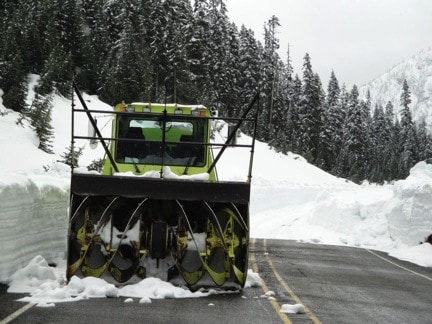Spring Is On It's Way

Spring means a lot of things. Growth. New life. Lots of color. Bright greens. Warmth. Sunshine. Rain. Melting snow. Longer days. Last month, cohort 12 graduate students spent a couple days hanging out at the Wilderness Awareness School in Duval, WA. The students there told us about the medicine wheel. The medicine wheel is a circular “wheel” with eight spokes. It can refer to parts of the day, different times of year, cardinal directions, stages of human life… Looking at it, I realized that there is a time for everything, and that if I pay attention to when that time is instead of ignoring it and just making plans, things turn out better. On the medicine wheel, spring falls in the east. It is the time for new beginnings and ideas, change, energy. It’s where the sun rises and the earth wakes up.
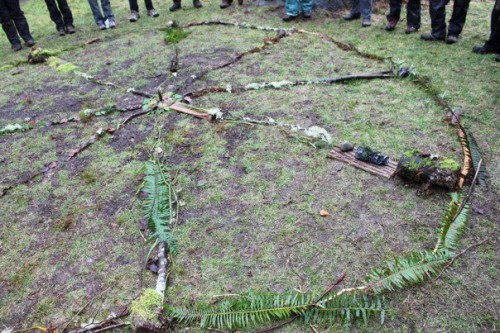 Standing around the medicine wheel after we all collaborated in piecing it together with found materials. Photo by Carey French
Standing around the medicine wheel after we all collaborated in piecing it together with found materials. Photo by Carey French
I can see the earth waking up every time I walk out my front door. Everywhere I look, plants and trees that have been bare and dormant all winter are showing little pops of color as buds form on their branches. The huckleberry is brightly pink and green now, the Red-flowering currant looks ready to explode, the Vine maple’s yellow-white twin terminal buds look toward the sun…
The birds are coming back too—the past couple of days I’ve been seeing and hearing Varied Thrushes, Dark-eyed Juncos, Pacific Wrens, and American Robins all over the place.
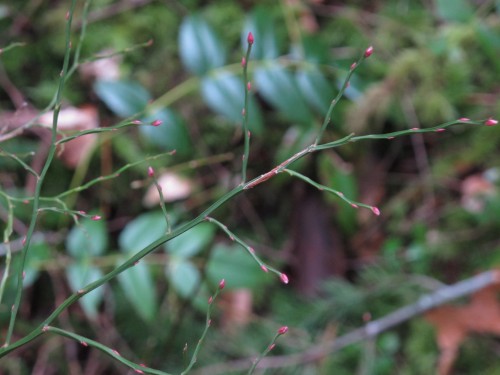 Buds on a Red Huckleberry shrub. Photo by Ryan Weisberg
Buds on a Red Huckleberry shrub. Photo by Ryan Weisberg
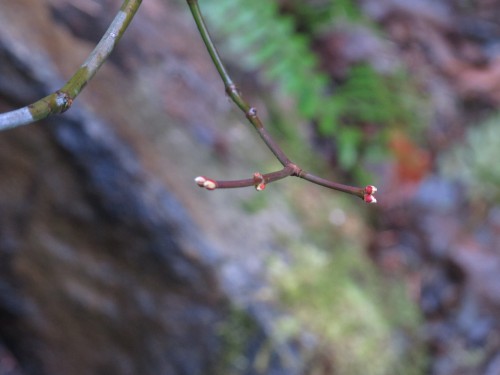 Buds on a Vine Maple. Photo by Ryan Weisberg
Buds on a Vine Maple. Photo by Ryan Weisberg
Other Institute staff and grad students shared with me their thoughts on the coming of spring…
“Though it feels like mere weeks since we began our residency, winter seems to have come and gone with spring here to take its place. All the forest is emerging from its frigid dormancy—the days are longer, the sun shines brighter, the birds sing sweetly, and all the plants are starting to show signs of regeneration. All around the Learning Center, one can find evidence of spring, in the catkins, buds, blooms, trills, twitters, animal-sightings, and melting snow levels. Life, it would seem, has awoken from its wintry daze.” – Sahara Suval, Graduate Student
“A good friend, and fellow bird nerd, and I were running the trails around lake Padden on March 2nd. We both share a deep love and passion for the outdoors, but on this day, we were focused on finishing our 6 mile run, ignorant of our surroundings. It was a beautiful day, with the temperature in the mid-5o’s. We bounded over rocks, roots and mud puddles, chatting about a wide array of topics, until something happened. We both stopped in our tracks, silenced by our desire to re-root ourselves in the forest, and straining to hear the beauty that spoke louder then our own voices. Someone finally broke the silence and asked “did you hear it?” The other nodded, hoping to hear it once again. In one brief second, the singular note of the Varied Thrush announced it’s return to the lowlands. Grounding us in nature, and reminding us of the power of age-old cycles, the Varied Thrush has alerted us that spring is coming.” – Steph Bennett, Graduate Program Coordinator
Bicycling on an empty snowy highway. Photo by Lindsey Frallic
“Biking Beyond the Gate: 2,000 feet of elevation gain and 44 miles round trip. The North Cascades Highway is gated between Ross Lake dam (MP 137) and Silver Star (MP 170) every year for six or seven months. Last year it took crews seven weeks to clear the snow and avalanche debris. I’m looking forward to following their progress and finding the perfect weekend to bike beyond the Ross Lake gate. I’m looking forward to having that road all to myself, to lay down in the middle of it and listen to the water running, to eat lunch on the snow machine at Rainy Pass, and to feel that climbing season is not too far away.” – Lindsey Frallic, Grant Coordinator
A snowplow past the gate, working to clear Highway 20. Photo by Lindsey Frallic
Blue sky, sun shining down
Prime time for adventuring
Birds singing of spring.
– Liza Dadiomov, Graduate Student
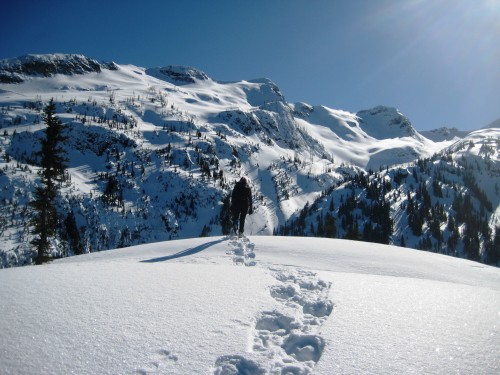 Beautiful blue skies make for a perfect day to climb Ruby Mountain, which you can see from the Learning Center. Photo by Liza Dadiomov
Beautiful blue skies make for a perfect day to climb Ruby Mountain, which you can see from the Learning Center. Photo by Liza Dadiomov
“This morning a thin curl of smoke rises from the chimney across the street. Ice on the car windows. Chickadees and white-crowned sparrows sing from the brushpile. Even though the purple crocuses have been blooming for a week or more, I look for the first flowers of native plants to tell me that spring is really here. Indian plum, then red flowering currant, and soon, rufous hummingbirds! It’s coming. It’s coming fast.” – Saul Weisberg, Executive Director
“I can’t wait to see my first hummingbird of the spring! Watching the salmonberry bushes closely….” – Christian Martin, Communications Coordinator
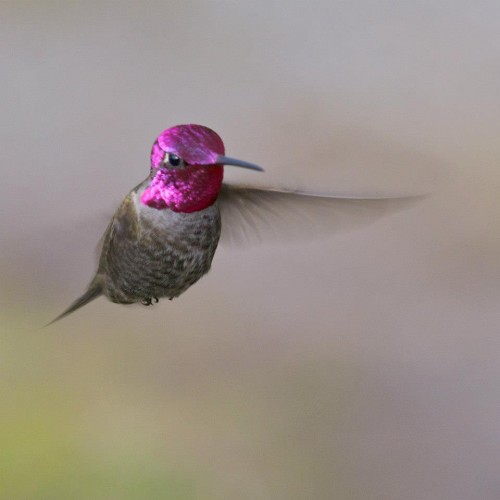 An adult male Anna’s Hummingbird, caught in mid-flight. A rare sight since these hummingbirds beat their wings 20-30 times per second and don’t stay in one place for very long. Photo by Libby Mills
An adult male Anna’s Hummingbird, caught in mid-flight. A rare sight since these hummingbirds beat their wings 20-30 times per second and don’t stay in one place for very long. Photo by Libby Mills
In addition to all the other signs of spring, one marker of the changing season that happens annually at the Learning Center is the week-long Capstone presentations and Graduation of the outgoing cohort. This year it’s the 14 students of cohort 11, who received their certificates in Leadership, Nonprofit Administration, and Natural History at the North Cascades Environmental Learning Center on 21 March 2013. At their Western Washington University graduation ceremony they’ll receive their M.Ed in Environmental Education. For more on cohort 11’s last week of graduate school, look for my next post.
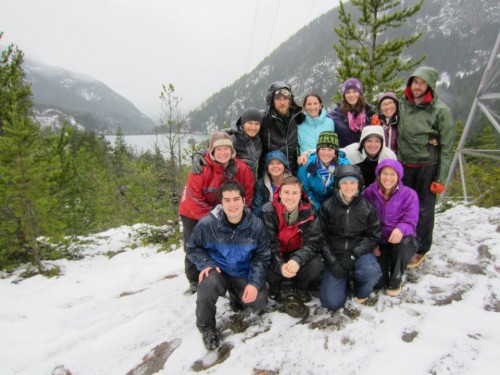 Cohort 11 in March of 2012 (back row L-R: Erin Soper, Alex Patia, Colby Mitchell, Sarah Bernstein, Katie Tozier, Kiira Heymann, Jacob Belsher. middle row L-R: Jess Newley, Susan Brown, Mollie Behn. front row L-R: Emmanuel Camarillo, Elise Ehrheart, Chris Kiser, Ashley Kvitek) Photo by Carolyn Waters
Cohort 11 in March of 2012 (back row L-R: Erin Soper, Alex Patia, Colby Mitchell, Sarah Bernstein, Katie Tozier, Kiira Heymann, Jacob Belsher. middle row L-R: Jess Newley, Susan Brown, Mollie Behn. front row L-R: Emmanuel Camarillo, Elise Ehrheart, Chris Kiser, Ashley Kvitek) Photo by Carolyn Waters
Leading photo: An Indian Plum starting to flower on the Mclane Creek Nature Trail in Olympia, Washington. Photo by Saul Weisberg
Ryan Weisberg is a graduate student in their third quarter of North Cascades Institute and Western Washington University’s M.Ed. program. They grew up here in Washington, exploring the natural areas around Bellingham and in the Cascades. Ryan is the Chattermarks editor this year during their residency at the North Cascades Environmental Learning Center.



